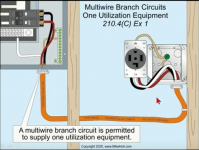Paul Ternstrom
Member
- Location
- North Carolina, USA
- Occupation
- Consulting Electrical Engineering
I guess this all comes down to definitions. I have never considered that the handle of the circuit breaker did not "trip off the load". In his seminars and teachings, Mike Holt has always stressed the importance of looking at the strict wording of the code and its definitions to get the root of what a section means. That's how this whole conversation got started - the inspector had his definition of what a MWBC was and we have gone back and forth discussing what a MWBC is. But it all comes back to the definition in Sec 100 which says a MWBC is two or more hots with a shared neutral. A line to line load is multiple wires, and is a branch circuit, but it is not a MWBC unless there is a neutral involved. So the requirements of 210(4) do not apply unless there is a shared neutral in the mix. Great conversation, everyone!


